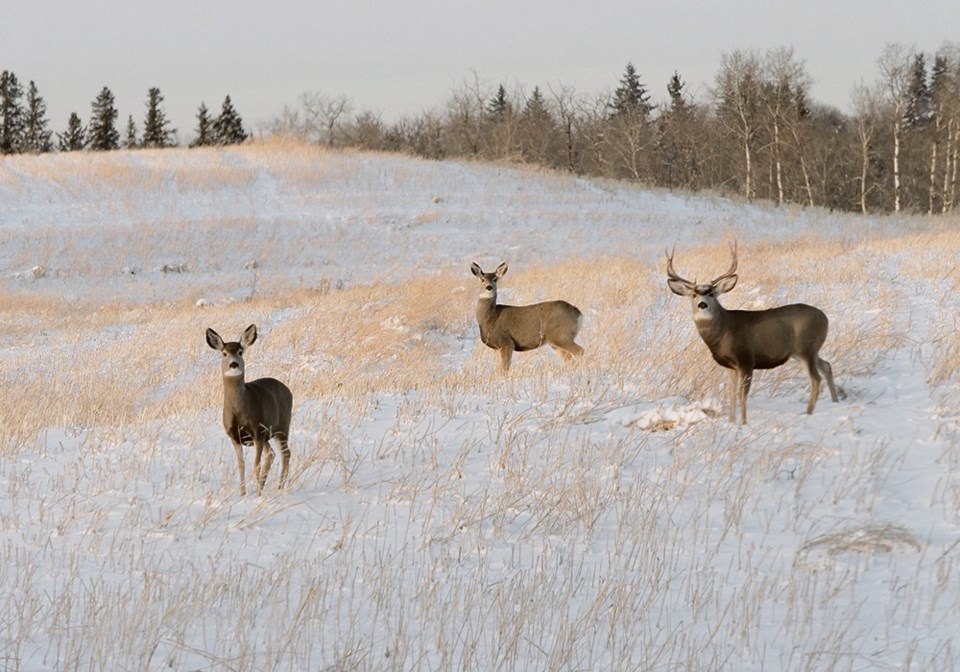WESTERN PRODUCER — Scientists in Western Canada have joined forces in a $1.28-million research project to try to develop an oral vaccine to reduce the spread of chronic wasting disease among wild deer species.
The rapid growth of the illness in Alberta and Saskatchewan is sparking concerns that it could eventually evolve to cross over into livestock, said Hermann Schaetzl, associate dean of research at the University of Calgary’s Faculty of Veterinary Medicine.
Other countries could block exports of Canadian agricultural products, he said, pointing to how Norway has already banned hay and straw due to what he called the psychological threat posed by the disease.
“It really is a problem against which we have to do something, so we cannot wait … it’s important to do something now to really continue to contain the disease.”
Chronic wasting disease (CWD) is caused by a structurally abnormal version of a protein called a prion, infecting the nervous systems and brains of deer species through things such as urine and feces, he said. It is fatal to mule deer and white-tailed deer, along with elk, moose, caribou, and reindeer.
Although BSE in cattle is also caused by prions, CWD is much more infectious and lingers in the environment, said Schaetzl, who is also scientific director of the University of Calgary’s Prion-Virology Animal Facility and head of the Calgary Prion Research Unit.
“CWD is at the moment considered the most infectious prion disease because we have so much infectivity coming out of the central nervous system and going to the outside and spreading into the environment.”
The research project involves five people over the next five years, said Todd Zimmerling, president and chief executive officer of the Alberta Conservation Association.
“And hopefully by the end of it, they come up with an oral vaccine that’s been tested on penned deer, and then of course the next step will be, ‘OK, how do we get it into wild populations?’ ”
Besides Schaetzl, the research team includes scientists Holger Wille of the University of Alberta; Neil Cashman of the University of British Columbia; and Philip Griebel and Scott Napper of the Vaccine and Infectious Disease Organization at the University of Saskatchewan.
They plan to examine five potential antigens and two oral delivery methods that could be distributed in affected habitats, said an ACA statement. Scientists will be “very happy” if they can create a vaccine for deer that provides even 50 to 60 percent protection against CWD, said Schaetzl.
The idea is to blunt enough of the spread of the disease so it starts to die out, he said. It will likely take years or decades for the vaccine to take effect in wild deer because it takes three to five years for deer to die from the time they are infected, he added.
“It’s a long-term approach and the vaccine alone will not solve the problem. We have to do a few other things. We have to be very strategic in how we apply it.”
The ACA will contribute $500,000 over five years to help fund the research project, joined by $400,000 from Saskatchewan’s Fish and Wildlife Development Fund. Alberta Environment and Parks will provide $381,000 over two years.
Meanwhile, the Alberta government’s Results Driven Agriculture Research (RDAR) fund has contributed $458,850 for research at the University of Alberta on the impact of CWD on crops in terms of agricultural exports.
It has also contributed $62,500 for research at the University of Calgary to look at the susceptibility to infection of animals such as mice, voles, ferrets and felines, which share the same geographical locations as wild deer.
The project will also examine the transmissibility of CWD to economically important species such as pigs and cattle, assessing the risk it poses to agriculture and public health, said a statement by Schaetzl.
Alberta Innovates and the Alberta Prion Research Institute are also funding five CWD projects totaling $1 million at the University of Calgary and the University of Alberta.
After being first detected in Colorado in the 1960s, the disease has since spread among deer species in 28 American states and four Canadian provinces. More than 3,500 cases have been found in Alberta alone since it was first confirmed in 2005 in a wild deer in the province’s southeast near the Saskatchewan border.
As much as one fifth of wild deer populations in some parts of Alberta have likely been infected, said Schaetzl.
“And as I said before, when you reach 20 percent in a population, it’s really getting ugly for the population.”
CWD has so far mostly affected white-tailed deer and mule deer, said Zimmerling. Although there is currently no evidence it can be transmitted to humans or animals such as cattle, the issue is in the back of everybody’s minds, he added.
“If for some reason, it starts to be able to jump, it obviously becomes a huge issue for everybody. But at this point, like I said, there’s been no evidence to suggest that it does.”




